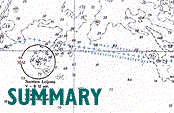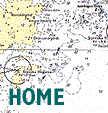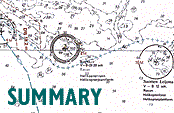CHAPTER 16 ANALYSIS OF THE EVACUATION |
16.1 The start of the evacuation |
 |
Many passengers, especially in cabins on deck 1 and in forward cabins on other decks, heard, during about 10 minutes, metallic sounds which they gradually found abnormal and alarming. These sounds frightened some of them. A few witnesses left their cabins, certain that something was amiss. Some left to investigate and others for the open deck 7.
 The majority of passengers and crew members, however, were not alarmed until the more powerful blows before the first heel. The noise and the subsequent list obviously made them immediately recognise the situation as life-threatening. Many then escaped hastily and without taking the time to put on proper clothing. The reaction pattern varied, however, and some passengers, although alarmed, did not seem to believe or grasp the seriousness of the situation, or could find no options for rational action. The majority of passengers and crew members, however, were not alarmed until the more powerful blows before the first heel. The noise and the subsequent list obviously made them immediately recognise the situation as life-threatening. Many then escaped hastily and without taking the time to put on proper clothing. The reaction pattern varied, however, and some passengers, although alarmed, did not seem to believe or grasp the seriousness of the situation, or could find no options for rational action.
 Most passengers and crew members were thus alarmed by the accident itself and started to seek the open decks spontaneously and, in most cases, individually. Alarm signals seem not to have had any significance for the passengers or for most of the crew. Most passengers and crew members were thus alarmed by the accident itself and started to seek the open decks spontaneously and, in most cases, individually. Alarm signals seem not to have had any significance for the passengers or for most of the crew.
|
 |
16.2 The mobilisation of the command group on the bridge |
 |
The officers on watch after 0100 hrs were the second officer A and the fourth officer. The master arrived at the bridge 5 to 10 minutes prior to the first heel and is believed to have stayed because of the ongoing inquiry about sounds from the visor and the ramp area. The complete command group did not gather on the bridge.
 The chief purser was awakened by the list and went directly to the open deck. The chief officer's voice was identified from the distress radio traffic together with the voices of the second officer A and the third officer. These two officers climbed out from the bridge when the ESTONIA had a list of approximately 80°. The Commission has no information about the chief engineer or the purser's assistant. The chief purser was awakened by the list and went directly to the open deck. The chief officer's voice was identified from the distress radio traffic together with the voices of the second officer A and the third officer. These two officers climbed out from the bridge when the ESTONIA had a list of approximately 80°. The Commission has no information about the chief engineer or the purser's assistant.
 Except for the chief purser, no member of the command group survived. Except for the chief purser, no member of the command group survived.
|
 |
16.3 Alarms and activities by the bridge |
 |
The bridge sent out alarm signals approximately five minutes after the list and when the situation had already become aggravated. The alarm they first used, Mr Skylight to number one and two, was a fire alarm which was coded so as not to disturb the passengers, but was, as most ”Mr Skylight” alarms, also a signal for mustering the command group and the lifeboat groups simultaneously.
 This alarm, which was not so well suited to the situation, came on at a time when there were already people wearing lifejackets below the bridge wing and when the list was around 30°. One of the two fire groups, to which this alarm was directed, was instructed to muster on the car deck which at about that time contained approximately 1,500 t of water. This alarm, which was not so well suited to the situation, came on at a time when there were already people wearing lifejackets below the bridge wing and when the list was around 30°. One of the two fire groups, to which this alarm was directed, was instructed to muster on the car deck which at about that time contained approximately 1,500 t of water.
 According to the safety manual the bridge could use a ”Mr Skylight” alarm if they wanted to prepare and organise the crew for an evacuation before alarming all the passengers. To muster the lifeboat groups, the command group should, according to their safety manual, use the ”Mr Skylight” alarm without any suffix. To muster the lifeboat groups and evacuation groups simultaneously they should have used ”Mr Skylight Evac” followed by the digits for each evacuation group. According to the safety manual the bridge could use a ”Mr Skylight” alarm if they wanted to prepare and organise the crew for an evacuation before alarming all the passengers. To muster the lifeboat groups, the command group should, according to their safety manual, use the ”Mr Skylight” alarm without any suffix. To muster the lifeboat groups and evacuation groups simultaneously they should have used ”Mr Skylight Evac” followed by the digits for each evacuation group.
 Approximately two minutes after the ”Mr Skylight” alarm, the lifeboat alarm came on. Approximately two minutes after the ”Mr Skylight” alarm, the lifeboat alarm came on.
 A possible explanation for the use of a ”Mr Skylight” alarm before the lifeboat alarm is that the bridge had not yet understood the seriousness of the situation but wanted to prepare the crew for evacuation. The use of this alarm was, however, inappropriate and late and suggests that there was confusion on the bridge and that the bridge was without a clear understanding of the situation. Since the lifeboat alarm came later it is reasonable to assume that this alarm and the distress radio call came close after one another and not before the bridge had fully perceived the situation as both life-threatening and irreversible. A possible explanation for the use of a ”Mr Skylight” alarm before the lifeboat alarm is that the bridge had not yet understood the seriousness of the situation but wanted to prepare the crew for evacuation. The use of this alarm was, however, inappropriate and late and suggests that there was confusion on the bridge and that the bridge was without a clear understanding of the situation. Since the lifeboat alarm came later it is reasonable to assume that this alarm and the distress radio call came close after one another and not before the bridge had fully perceived the situation as both life-threatening and irreversible.
 Some survivors have reported hearing the alarms, but others report not having heard any alarm at all. Other survivors only heard parts of these alarms over the noise in the ship and most passengers did not understand what the alarms meant. No additional information was sent from the bridge. Some survivors have reported hearing the alarms, but others report not having heard any alarm at all. Other survivors only heard parts of these alarms over the noise in the ship and most passengers did not understand what the alarms meant. No additional information was sent from the bridge.
 The rapid development of the accident made organised efforts by the rest of the crew impossible. The rapid development of the accident made organised efforts by the rest of the crew impossible.
|
 |
16.4 Activities by crew members |
 |
The ”Häire, häire laeval on häire” (Alarm, alarm there is alarm on the ship) message which came on prior to the alarms was probably not authorised from the bridge but sent on the initiative of the crew member at the information desk. This message might have had some effect upon the evacuation but it was mostly understood by Estonians only. Evidently it was interrupted at the very moment it was to be repeated in English.
 Some individual crew members, however, took responsibility and initiative for alarming, and organised the evacuation locally by guiding passengers, helping, arranging human chains, distributing lifejackets and releasing liferafts. Divers' findings of ropes and a lifeboat rope ladder down the staircase aft at deck 6 are further evidence of efforts led by crew members to rescue those inside. A witness statement concerning individuals, probably crew members, keeping passengers back in a staircase may be referring to an attempt to organise the escape. It is understandable that crew members, before being ordered to evacuate or hearing any alarm signals, might try to neutralise spontaneous escape. Some individual crew members, however, took responsibility and initiative for alarming, and organised the evacuation locally by guiding passengers, helping, arranging human chains, distributing lifejackets and releasing liferafts. Divers' findings of ropes and a lifeboat rope ladder down the staircase aft at deck 6 are further evidence of efforts led by crew members to rescue those inside. A witness statement concerning individuals, probably crew members, keeping passengers back in a staircase may be referring to an attempt to organise the escape. It is understandable that crew members, before being ordered to evacuate or hearing any alarm signals, might try to neutralise spontaneous escape.
 The chief task of the crew was to take responsibility for and organise the evacuation of the passengers. The Commission understands, however, that this became almost impossible as the situation later developed into imminent deadly peril to all, irrespective of category. The chief task of the crew was to take responsibility for and organise the evacuation of the passengers. The Commission understands, however, that this became almost impossible as the situation later developed into imminent deadly peril to all, irrespective of category.
 Taking responsibility implies risk-taking and risks during the accident were evenly distributed among both crew and passengers. The crew members' responsibilities were to see to passengers' well-being, to help and to use their knowledge and training actively in the rescue efforts. Passengers are justified in expecting that crew members should be aware of their responsibilities and at least be active. The reported passivity of some crew members, the delay in alarming and the lack of guidance from the bridge suggest that training and preparations were not sufficient. Taking responsibility implies risk-taking and risks during the accident were evenly distributed among both crew and passengers. The crew members' responsibilities were to see to passengers' well-being, to help and to use their knowledge and training actively in the rescue efforts. Passengers are justified in expecting that crew members should be aware of their responsibilities and at least be active. The reported passivity of some crew members, the delay in alarming and the lack of guidance from the bridge suggest that training and preparations were not sufficient.
 A further indication of this was that members of the catering staff apparently did not play any specific role in the evacuation. Their duties were to form a first aid group, a guard group and 11 evacuation groups. When not involved in other duties, they were assigned to man the lifeboat and liferaft rescue stations. Individual members of the deck and engine crew, however, took responsibility for passengers and fellow crew members. Some of these crew members, including two who did not survive, made heroic contributions and were very active, apparently disregarding their own safety. Passengers also helped and supported each other, often sticking together in twos or in small groups. A few especially energetic and active passengers also helped to organise and to direct others. A further indication of this was that members of the catering staff apparently did not play any specific role in the evacuation. Their duties were to form a first aid group, a guard group and 11 evacuation groups. When not involved in other duties, they were assigned to man the lifeboat and liferaft rescue stations. Individual members of the deck and engine crew, however, took responsibility for passengers and fellow crew members. Some of these crew members, including two who did not survive, made heroic contributions and were very active, apparently disregarding their own safety. Passengers also helped and supported each other, often sticking together in twos or in small groups. A few especially energetic and active passengers also helped to organise and to direct others.
|
 |
16.5 Obstructions to the evacuation |
 |
Besides the increasing list, the architecture of the ESTONIA made the evacuation difficult. Most corridors and staircases in the cabin areas were 1.2 m wide. This was probably sufficient space for two normally-built people to pass each other but when people were crowding, standing still or lying and crawling on the floor, movement in such a limited space became difficult with reasonable consideration and without forcing one's way. Such narrow longitudinal corridors were also apparently difficult to move in when the list exceeded 30°. At about 45°, effective movement along the corridors became almost impossible for any adult of normal build.
 Deck 1 contained cabins for 358 passengers. All the transverse corridors ended in the only longitudinal, and almost equally narrow, central corridor where there were six staircases. The limited width of this corridor, combined with the crowding and the disorganised behaviour of many passengers, probably created an insurmountable obstacle when the evacuation started. Deck 1 contained cabins for 358 passengers. All the transverse corridors ended in the only longitudinal, and almost equally narrow, central corridor where there were six staircases. The limited width of this corridor, combined with the crowding and the disorganised behaviour of many passengers, probably created an insurmountable obstacle when the evacuation started.
 It is believed that the narrow width of the corridors in combination with the list contributed to the crowding and the irrational behaviour. It is believed that the narrow width of the corridors in combination with the list contributed to the crowding and the irrational behaviour.
 Although the width of the corridors and evacuation staircases complied with the SOLAS Convention the Commission considers that this limited width constituted a major evacuation obstacle for most of the passengers. The Commission concludes that the applicable regulation in SOLAS was not appropriate, as demonstrated in this accident. Although the width of the corridors and evacuation staircases complied with the SOLAS Convention the Commission considers that this limited width constituted a major evacuation obstacle for most of the passengers. The Commission concludes that the applicable regulation in SOLAS was not appropriate, as demonstrated in this accident.
 Only a few witness reports are from people who escaped through the forwardmost port staircase. One of these stated that there was no crowding. The divers' investigation revealed, however, that a large number of people got stuck in this staircase on all decks and landings inspected. A possible interpretation is therefore that this staircase was more difficult to climb because of its transverse direction and that those few who did manage to reach the open deck did so when the list was still minor. Only a few witness reports are from people who escaped through the forwardmost port staircase. One of these stated that there was no crowding. The divers' investigation revealed, however, that a large number of people got stuck in this staircase on all decks and landings inspected. A possible interpretation is therefore that this staircase was more difficult to climb because of its transverse direction and that those few who did manage to reach the open deck did so when the list was still minor.
 Other obstacles to evacuation were objects which came loose and blocked the escape ways or struck people who were trying to escape. Heavy objects such as vending machines, gambling machines, flowerpots and some furniture in passageways and foyers should have been fixed to either deck or bulkheads. Some objects slid away, others came loose when the list was still small and heavy fixed objects later broke loose from their fastenings when the list increased. Also sliding carpets and slippery flooring material prevented some from evacuating and created obstacles that slowed others down. Other obstacles to evacuation were objects which came loose and blocked the escape ways or struck people who were trying to escape. Heavy objects such as vending machines, gambling machines, flowerpots and some furniture in passageways and foyers should have been fixed to either deck or bulkheads. Some objects slid away, others came loose when the list was still small and heavy fixed objects later broke loose from their fastenings when the list increased. Also sliding carpets and slippery flooring material prevented some from evacuating and created obstacles that slowed others down.
 The Commission has noted that some decorative objects were not properly fastened and also that heavy fixed objects broke loose within an angle of heel at which people still had possibilities to evacuate. These objects injured some or otherwise prevented the movement of others. It is therefore evident that more people could have reached the open deck had they not been hampered by the loose or sliding objects. The Commission has noted that some decorative objects were not properly fastened and also that heavy fixed objects broke loose within an angle of heel at which people still had possibilities to evacuate. These objects injured some or otherwise prevented the movement of others. It is therefore evident that more people could have reached the open deck had they not been hampered by the loose or sliding objects.
 The Commission considers that all objects along evacuation routes such as passageways, staircases and foyers should be fixed and properly fastened with no possibility to break loose within a range of list where people are still able to move and have the possibility to evacuate. Flooring material should also be fastened and, especially in open areas like foyers, slippery material should be avoided so as to facilitate movement on moving and sloping floors. The Commission considers that all objects along evacuation routes such as passageways, staircases and foyers should be fixed and properly fastened with no possibility to break loose within a range of list where people are still able to move and have the possibility to evacuate. Flooring material should also be fastened and, especially in open areas like foyers, slippery material should be avoided so as to facilitate movement on moving and sloping floors.
|
 |
16.6 Passengers' and crew members' reactions |
 |
The large number of people and their various reaction patterns also created an obstacle to the evacuation. During the evacuation, people had, because of the increasing list, increasing difficulties to move. A number of people fell or slid, thereby creating obstacles for others. Others were standing but not moving, thereby preventing others from passing them. Many were seen just holding on without moving; yet others appeared paralysed and seemingly unable to understand what was happening. From the very start of the list many were reported to be passive and stiff, despite reasonable possibilities for escaping.
 A few of those who survived behaved in an irrational way, but most did not. A number of people reacted incredulously to the very early signs. They slowly realised that the sounds they heard were abnormal, or rather, they failed to persuade themselves that the situation was still normal. When they became clear about the situation, they acted promptly and with a clear goal: to get out to deck 7. They were the first to evacuate. A few of those who survived behaved in an irrational way, but most did not. A number of people reacted incredulously to the very early signs. They slowly realised that the sounds they heard were abnormal, or rather, they failed to persuade themselves that the situation was still normal. When they became clear about the situation, they acted promptly and with a clear goal: to get out to deck 7. They were the first to evacuate.
 A majority of those rescued, however, seem to have grasped the seriousness of the situation when the blows and the list came. They also promptly understood what to do and thus reacted clearly and appropriately. Not without fear they yet managed to remain rational and to move effectively. A majority of those rescued, however, seem to have grasped the seriousness of the situation when the blows and the list came. They also promptly understood what to do and thus reacted clearly and appropriately. Not without fear they yet managed to remain rational and to move effectively.
 Many elderly people were seen making no or only faint efforts to escape. A great number of people were panicking, i.e. behaving without control, and screaming. Some of these were moving but not in a rational or purposeful way. Others were apathetic and some only held on to something without making further efforts to save themselves. Many elderly people were seen making no or only faint efforts to escape. A great number of people were panicking, i.e. behaving without control, and screaming. Some of these were moving but not in a rational or purposeful way. Others were apathetic and some only held on to something without making further efforts to save themselves.
 A number of people were shocked and seemingly unable to understand what was going on or what to do. Some of these seem to have been incapable of rational thought or behaviour because of their fear, and screamed or moaned helplessly; others appeared petrified and could not be forced to move. Some panicking, apathetic and shocked people were beyond reach and did not react when other passengers tried to guide them, not even when they used force or shouted at them. Other people tried to escape but lacked the strength to continue climbing, became exhausted and held onto handrails, blocking the way for others. A number of people were shocked and seemingly unable to understand what was going on or what to do. Some of these seem to have been incapable of rational thought or behaviour because of their fear, and screamed or moaned helplessly; others appeared petrified and could not be forced to move. Some panicking, apathetic and shocked people were beyond reach and did not react when other passengers tried to guide them, not even when they used force or shouted at them. Other people tried to escape but lacked the strength to continue climbing, became exhausted and held onto handrails, blocking the way for others.
 The Commission considers that information from the bridge over the public address system could have affected peoples' behaviour, especially if the system had been used to give orders to the passengers and the crew. Authoritative instructions could have saved many bewildered people, and should have been sent during the first few minutes in the development of the accident. The Commission considers that information from the bridge over the public address system could have affected peoples' behaviour, especially if the system had been used to give orders to the passengers and the crew. Authoritative instructions could have saved many bewildered people, and should have been sent during the first few minutes in the development of the accident.
 Spontaneous altruistic behaviour during the evacuation seems to have been more prevalent in the early stages where many people helped and took responsibility for each other or urged each other to move and climb. The building of human chains involved many, both crew members and passengers, but these efforts ceased when it became difficult to hold on and when people became afraid. Collective and co-operative efforts then broke down into individual efforts. Some collective and spontaneous attempts were made later on when people felt more secure. Those who had reached the open deck helped each other again and also tried to help those still trapped on the staircases. There are also indications that constructive communication between the escaping people broke down when they started to flee individually. Spontaneous altruistic behaviour during the evacuation seems to have been more prevalent in the early stages where many people helped and took responsibility for each other or urged each other to move and climb. The building of human chains involved many, both crew members and passengers, but these efforts ceased when it became difficult to hold on and when people became afraid. Collective and co-operative efforts then broke down into individual efforts. Some collective and spontaneous attempts were made later on when people felt more secure. Those who had reached the open deck helped each other again and also tried to help those still trapped on the staircases. There are also indications that constructive communication between the escaping people broke down when they started to flee individually.
 Many of the survivors forced their way, whereas others seem to have ceased struggling at some stage, as if giving themselves up for lost. Some have stated that they also, at some time, felt a strong urge to give up although they still possessed some strength. This strong feeling came over them when they suddenly felt their situation was hopeless. Overwhelmed, they lost all mental and physical strength and became passive. They regained their strength and willpower after coming to think of their loved ones, especially of children. Then they immediately decided to continue their struggle with great force and try to live on, as if needing an outside reason for staying alive. Many of the survivors forced their way, whereas others seem to have ceased struggling at some stage, as if giving themselves up for lost. Some have stated that they also, at some time, felt a strong urge to give up although they still possessed some strength. This strong feeling came over them when they suddenly felt their situation was hopeless. Overwhelmed, they lost all mental and physical strength and became passive. They regained their strength and willpower after coming to think of their loved ones, especially of children. Then they immediately decided to continue their struggle with great force and try to live on, as if needing an outside reason for staying alive.
 During the struggle people became injured or forced out of the way by others. Consideration for others and rules of behaviour ceased at moments when individuals perceived themselves to be in a death-trap. A situation arose where many took care of themselves only. More primitive behaviour was revealed and some were apparently rescued at the expense of others. During the struggle people became injured or forced out of the way by others. Consideration for others and rules of behaviour ceased at moments when individuals perceived themselves to be in a death-trap. A situation arose where many took care of themselves only. More primitive behaviour was revealed and some were apparently rescued at the expense of others.
|
 |
16.7 The limits for evacuation and the outcome |
 |
The Commission has estimated that the possibilities for escape to the ESTONIA's open decks ceased when the list was between 45 and 50 degrees. Around these angles there might perhaps still be some possibilities to get out for the few who were agile enough, who also had suitable footwear and who received help from others inside or out on deck. The time span for the evacuation to the open decks, from the time people started to the 45-to 50-degree list, was thus between 15 and 20 minutes. For the majority, who were not alarmed until the first heel, the time span was about 10 minutes. Bearing the narrow corridors and the great number of people in mind, this time span was extremely short.
 During this time at least 237 reached the open decks. This includes people who were seen on deck 7 and 8 but are still missing, 138 rescued, one of whom died in hospital, and 70 of the 94 bodies found. Next day 24 bodies were found near the wreck and it is very likely that they had come up from inside the wreck. This figure of 237 tallies with witnesses' statements that between 200 and 300 people were seen out on deck. During this time at least 237 reached the open decks. This includes people who were seen on deck 7 and 8 but are still missing, 138 rescued, one of whom died in hospital, and 70 of the 94 bodies found. Next day 24 bodies were found near the wreck and it is very likely that they had come up from inside the wreck. This figure of 237 tallies with witnesses' statements that between 200 and 300 people were seen out on deck.
|
 |
16.8 The rescue equipment |
 |
Crew members were seen working methodically releasing liferafts and distributing lifejackets. Passengers out on deck, however, had difficulties to understand how to put on the lifejackets. Instructions were in most cases not looked for, not found, not read or not understood correctly. This was sometimes due to passengers being overwhelmed by emotions and also to a stress-related narrowing of consciousness and perception. Passengers even struggled to release liferafts on their own although this task was intended for crew members only. In other cases, planless and highly stressed attempts were made by many passengers simultaneously, with nobody able to take the lead or have the time to work more methodically. Some individual passengers who were quite competent, active and rational also failed in their attempts.
 At least one container with lifejackets came loose and fell into the sea. Many survivors have stated that the lifejackets appeared old-fashioned while a common opinion among those rescued was that it was difficult to understand how to use them and how to put them on. Many lifejackets were tied together in threes and were difficult to separate. Lifejackets were also torn off when people hit the water. Survivors reported that the lifejackets appeared incomplete, with missing straps or straps that seemed too short. People had to help each other both to understand how to use the jackets and also to put them on. At least one container with lifejackets came loose and fell into the sea. Many survivors have stated that the lifejackets appeared old-fashioned while a common opinion among those rescued was that it was difficult to understand how to use them and how to put them on. Many lifejackets were tied together in threes and were difficult to separate. Lifejackets were also torn off when people hit the water. Survivors reported that the lifejackets appeared incomplete, with missing straps or straps that seemed too short. People had to help each other both to understand how to use the jackets and also to put them on.
 The reports from witnesses are in line with reports from rescue units and personnel searching the water during the days after the accident. They found several drifting bundles of lifejackets tied together. Members of various rescue units also confirmed that they found very few people wearing lifejackets that had been put on correctly. The reports from witnesses are in line with reports from rescue units and personnel searching the water during the days after the accident. They found several drifting bundles of lifejackets tied together. Members of various rescue units also confirmed that they found very few people wearing lifejackets that had been put on correctly.
 It is therefore the Commission's opinion that the design of lifejackets should be simplified so that their proper use appears self-evident even for untrained people, and also that instructions on liferafts and liferaft containers should be very short, distinct, easy to find and to understand. It is therefore the Commission's opinion that the design of lifejackets should be simplified so that their proper use appears self-evident even for untrained people, and also that instructions on liferafts and liferaft containers should be very short, distinct, easy to find and to understand.
 No one left the ship in an orderly fashion. Some were forced to jump, but most were swept into the sea by waves or slid into the sea inside or outside liferafts. No one left the ship in an orderly fashion. Some were forced to jump, but most were swept into the sea by waves or slid into the sea inside or outside liferafts.
 |
 |







